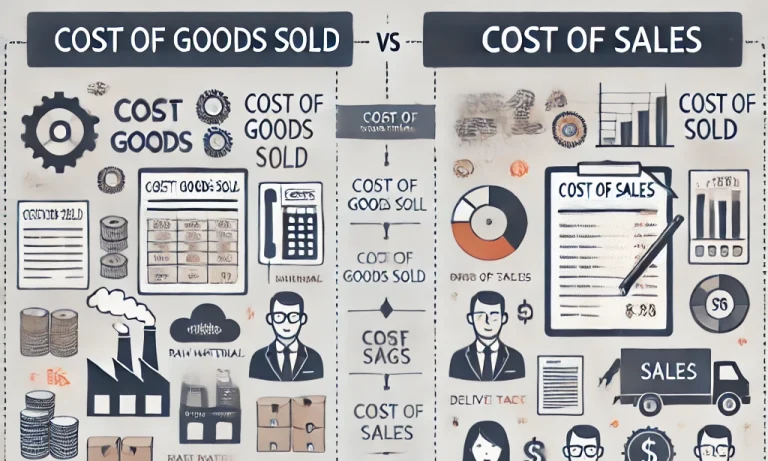Understanding the difference between them is critical for appropriate financial analysis and reporting. For manufacturing businesses, COGS is used in the determination of gross profit. This computation directly measures how efficiently the company produces its goods. Businesses that provide services, such as consultancy or financial services, do not have COGS. Instead, they will have a cost of sales to reflect the cost of providing the service, which may include wages for the employees involved, technology, or any other service-related expense. The cost of sales tends to be broader and includes the costs associated with selling a product or service in addition to manufacturing. For example, the cost of packaging, shipping, and distribution falls under the cost of sales. These additional costs are crucial to understanding a company’s full operational expenses.
Difference Between Cost of Sales and Cost of Goods Sold
The cost of goods sold and cost of sales are important parts of any firm’s financial statements. Both refer to the direct costs of making goods or services sold in a given period. However, it is necessary to understand how the cost of goods sold differs from the cost of sales, as they will influence profitability as well as the general analysis of the firm’s financials.
| Aspect | Cost of Goods Sold (COGS) | Cost of Sales (COS) |
|---|---|---|
| Scope | Only includes costs directly related to manufacturing goods. | Includes COGS and additional costs related to the sales process, often including distribution. |
| Applicable Industry | Mainly used in product-based businesses (manufacturers, retailers). | Applies to both product-based and service-based industries. |
| Components | Raw materials, direct labor, and manufacturing overhead. | Includes COGS, distribution costs, and service-related expenses. |
| Financial Statement Impact | Appears on the income statement to calculate gross profit. | Appears on the income statement and can be more complex due to additional costs. |
| Sales Calculation | Directly impacts the calculation of gross profit by subtracted from sales revenue. | Can affect gross profit and sometimes operating profit, depending on the complexity of the costs included. |
| Inventory Impact | Affects inventory turnover and gross margin directly. | Can also influence profitability but in a broader context than COGS. |
| Profitability Insights | Helps businesses understand the efficiency of production. | Provides a broader picture of costs directly tied to both production and sales processes. |
Meaning of Cost of Goods Sold
The cost of goods sold is simply the direct costs incurred by a business to produce goods sold over a certain period. These costs are subtracted from the revenue generated by a business to calculate its gross profit. Because COGS determines profitability, it is especially relevant for a business selling tangible products—for instance, manufacturers, wholesalers, and retailers.
Key Components of COGS:
COGS typically includes the following expenses:
- Raw Materials: The cost of the materials used to produce the finished goods.
- Direct Labor: Wages of workers who are directly involved in manufacturing the goods.
- Manufacturing Overhead: Includes utilities, rent, and equipment depreciation associated with the production process.
For instance, a company that produces shoes will include the cost of leather, thread, and shoelaces as raw materials in COGS. Similarly, the labor cost of workers assembling the shoes falls under direct labor.
COGS in Financial Statements:
COGS appears on the income statement and is subtracted from total sales to calculate gross profit. The formula for calculating COGS is:
COGS = Beginning Inventory + Purchases During the Period – Ending Inventory
This formula reflects the movement of inventory, accounting for the costs associated with acquiring goods during the period.
Impact of COGS on Profitability
A low COGS means a higher gross profit margin, signifying that the company produces goods more efficiently at lower costs. On the other hand, a high COGS may imply inefficiencies or rising production costs that would squeeze profit margins.
In brief, the meaning of cost of goods sold lies in the direct expense incurred in generating physical products. It is one of the financial indicators that has one of the greatest implications on the gross profit and profitability of the company.
Meaning of Cost of Sales
Cost of sales (COS) is a general term used to depict the total cost a company incurs to sell its products or services. Like COGS, it encompasses direct costs related to production but includes additional costs whose connection is with the process of selling. In service-related industries such as healthcare and consulting, for example, the cost of sales could include the wages of employees providing services or other relevant costs.
Key Components of COS
- COGS: The direct costs associated with producing goods.
- Selling Costs: This includes advertising, sales commissions, marketing, and other costs tied to the selling process.
- Distribution Costs: Expenses related to shipping, handling, and storing goods.
- Service-Related Costs: For service businesses, this includes employee wages, technology, and any infrastructure needed to deliver the service.
For example, in a restaurant, COS would include not just the cost of ingredients and wages for kitchen staff (like COGS), but also the cost of waitstaff, cleaning supplies, and utilities used in the dining area.
COS in Different Industries
In product-based industries, the cost of sales may closely resemble the COGS figure, but for service industries, COS extends beyond the manufacturing or production costs. For example:
- A consulting firm would include employee salaries, software subscriptions, and other service delivery expenses under COS.
- A retailer would include the cost of goods, distribution, and sales expenses under COS.
Impact of COS on Profitability
Like COGS, the cost of sales directly impacts gross profit. However, because COS encompasses production as well as selling expenses, it forms an even larger measure of profitability. Companies with very high COS would need to reassess their operational efficiency or pricing to continue being profitable.
Essentially, the cost of sales is a better picture than COGS as it encompasses the entire expenses incurred in reaching the product or service to the marketplace.
Difference Between Cost of Goods Sold and Net Sales
It is very important to understand the difference between cost of goods sold and net sales in the assessment of a company’s profitability. Both these figures appear on the income statement but serve different purposes and are calculated differently.
Net Sales
Net sales are usually defined as a company’s total sales revenue after adjustments for returns, allowances, and discounts. The net sales bring forward the amount of revenue generated that actually forms part of the expenses being covered, including COGS and other running costs.
COGS and Net Sales in Profitability
The difference between COGS and net sales lies in the purpose they serve in determining a company’s profitability. Net sales represent the revenue generated from sales, while COGS represents the direct costs incurred to produce the goods sold.
To calculate gross profit, we subtract COGS from net sales:
Gross Profit = Net Sales – COGS
This gross profit figure helps determine how efficiently a company is producing its goods and managing its production costs.
Cost of Goods Sold and Cost of Sales FAQs
What is the difference between cost of goods sold and cost of sales?
The primary difference between cost of goods sold and cost of sales is that COGS refers specifically to the direct costs incurred to manufacture goods, while cost of sales includes COGS along with additional costs related to selling, distribution, and service delivery.
How is the cost of sales calculated?
The cost of sales is calculated by adding together the cost of goods sold, selling expenses, distribution costs, and any other expenses tied to the sale of goods or services.
Is cost of sales the same in service industries as in product-based businesses?
No, in service industries, cost of sales primarily includes the costs associated with delivering the service, such as labor and operational costs, while in product-based businesses, it includes both production and selling costs.


